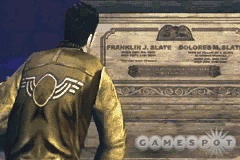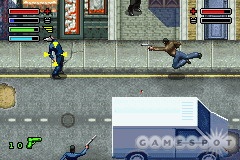Many of the features that made Dead to Rights such an interesting console offering, such as the bullet-time camera effects, the bloody and violent disarms and killing moves, and the police dog attack sequences, have been toned down, removed entirely, or implemented in such ways that they're impractical to use in the Game Boy Advance version of the game. At the same time, the shooting interface is unreliable and tough to get the hang of, which is unfortunate considering that Dead to Rights is supposedly an action game steeped in gunplay.

What the GBA version does best is present its story and dialogue sequences in attractive manners. Dead to Rights tells the tale of a vigilante cop named Jack Slate. His mission is to discover who framed him for murder and who killed his father. The whole game takes place in the buildings and on the streets of Grant City, a rainy and gritty place that's full of low-life scum. Although the GBA is incapable of reproducing the 3D animated cinematic intermissions the console game featured, the development team has done a good job of re-creating those scenes by using a combination of still images and text overlays. After completing each level, players are rewarded with glimpses into the aftermath of Slate's rampages, and sometimes the scenes can be a little violent or bloody.
It's ironic that the cinematics actually show some bloodshed once in a while, because none of the actual levels do. All the action in the console versions of Dead to Rights took place from a third-person viewpoint that clearly showed Slate shooting holes in hoodlums, as well as snapping their necks before taking away their guns. In fact, DTR was one of the first console games to show lifelike violence with 3D graphics, as it came out shortly after Grand Theft Auto III. The graphics here are of the 2D variety, which isn't an unexpected compromise, and the action is presented from a top-down viewpoint that doesn't do a bad job of giving players a bird's-eye view of what's going on. None of the blood splatters and violent deaths that helped make the console game so interesting were put into the GBA version, so when you shoot someone or perform a martial arts attack, the person will just fall down and disappear. Worse yet, the stylish disarm moves that added even more panache to the console offerings weren't implemented in the GBA counterpart either.
Included on the vast list of features from the console game that didn't make it into the GBA iteration is the crime drama soundtrack that added to the console version's film noir atmosphere. Except for a few pulsing beats and dramatic crescendos, this version's soundtrack consists mainly of the gunshots that Jack and his enemies trade back and forth, along with some explosions here and there. Likewise, the majority of voice work was removed, except for a few grunts and groans that occur when a thug meets his demise.
With so many features cut out or trimmed down, Dead to Rights on the GBA is just a standard top-down-view shoot-'em-up with nothing unique going for it. Nonetheless, this isn't the totality of the game's problems. Generally speaking, the goal in each level is to kill all the bad guys and make it to the exit. To achieve this end, you can move Slate around in the environment, pick up any weapons that are lying around, and shoot the enemy by first targeting him or her with the R button and then firing with the A button. The B button lets you toggle between fists and guns, and pressing R and B simultaneously lets you cycle through whatever weapons Jack is carrying. Additionally, double-tapping the L button lets you activate a bullet-time state that lets Jack leap forward so he can fire off multiple shots while the action moves in slow motion. Furthermore, you can press L and B simultaneously to let Jack's police dog go after a targeted enemy in hopes of fetching his or her weapon. The dog attack takes a good 30 seconds to recharge, so you probably won't use it often, though.
While this control layout is unnecessarily complex, as well as a total pain to get used to, the real problem with the controls is that they're unreliable. Frequently, the targeting cursor won't appear over the enemy and/or shots won't even come out of your gun. The bullet-time effect also has a habit of either not kicking in or shutting off right away, which is probably due to the way the GBA handles the quick double-tap activation sequence. Another significant problem has to do with the way the game handles enemies that are offscreen. Basically, they can target and shoot at you from outside the frame, but you can't target them or fire back until they're visible.

Despite the poorly programmed gunplay and the counterintuitive controls, it's actually possible to play through and finish the GBA version of Dead to Rights in about one hour. There are health packs and armor packs scattered liberally throughout each level, and most of the bosses only put up a mild degree of resistance, which can be alleviated by shooting them, grabbing a health pack, and then shooting them some more. That's quite different from the console version, where the bosses were well armed and often had subtle weaknesses that took numerous failures to discover. There's a lock-picking minigame that pops up once in a while, and there's a single occurrence of a weight-lifting one, but otherwise, the majority of these minigames from the console version were left out of the GBA version, which further shaves some time off how long the whole storyline takes to finish.
Even if more care had been taken to both iron out the kinks in the controls and eliminate some of the hiccups with the targeting system, Dead to Rights for the GBA still wouldn't pass muster. Most of the things that made it a unique console game were removed or greatly watered down, leaving behind a repetitive shoot-'em-up that doesn't kindle a desire to replay it, let alone play through it once.